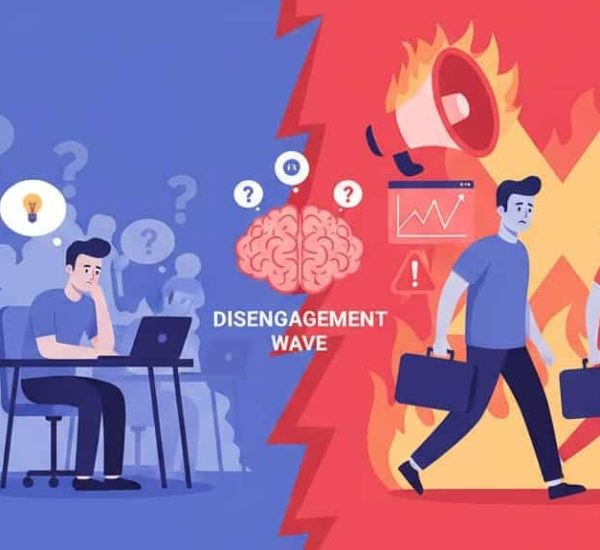Workplace wellness has traditionally focused on physical health—encouraging exercise, promoting nutritious eating, and providing healthcare benefits. But in today’s fast-paced and high-pressure work environments, wellbeing and resilience go far beyond gym memberships and step challenges. Emotional and mental health are just as critical to long-term success, both for individuals and organizations.
Businesses that prioritize workplace wellness with a holistic approach—one that includes emotional resilience and mental well-being—help employees manage stress, navigate challenges, and stay engaged. A culture of wellness and resilience fosters not only happier employees but also stronger, more adaptable teams.
A 2017 survey by the American Psychological Association (APA) revealed that the workplace was the third most common source of stress for Americans, with 61% citing it as a significant stressor—closely following financial concerns (62%) and uncertainty about the nation’s future (63%). citeturn0search4
Similarly, Mind Share Partners’ 2019 Mental Health at Work Report found that over 60% of respondents reported that their mental health had a direct impact on their productivity at work. Additionally, over one-third believed that their job or workplace environment contributed to their symptoms. citeturn0search1 The economic burden of mental health conditions and substance abuse on employers is substantial, with annual indirect costs estimated between $80 billion and $100 billion.

The Business Cost of Burnout: Why HR Leaders and Managers Need to Act
Employee burnout isn’t just a personal struggle—it’s a workplace crisis with serious financial consequences. For HR leaders and managers, ignoring employee stress leads to higher turnover rates, absenteeism, and lost productivity, all of which impact the company’s bottom line.
Burnout Is Driving Turnover and Productivity Loss
According to Gallup, burned-out employees are 2.6 times more likely to be actively job searching and 63% more likely to take a sick day (source). Meanwhile, a report by Deloitte found that 77% of employees have experienced burnout at their current job, yet 69% feel their employer doesn’t do enough to prevent it (source).
This means HR leaders and managers can’t afford to see workplace wellness as a perk—it’s a business necessity. Companies that fail to address wellbeing and resilience risk losing top talent and creating a disengaged workforce.
Emotional Resilience as a Solution
Building emotional resilience among employees isn’t just about preventing stress—it’s about helping teams adapt to challenges, recover from setbacks, and stay engaged. Research from the Harvard Business Review highlights that organizations investing in mental resilience training see increased employee engagement and long-term retention (source).
For HR leaders and managers, this means shifting the focus from short-term wellness initiatives (like one-off mental health workshops) to long-term resilience strategies that help employees thrive in the face of workplace pressures.
The Cost of Burnout vs. The Benefits of Resilience
| Factor | The Cost of Burnout | The Benefits of Resilience |
| Productivity Loss | Billions are lost annually due to burnout-related turnover | Resilient employees perform 18% better (source) |
| Absenteeism | 63% increase in absenteeism due to burnout (source) | Mental resilience training reduces stress-related absences |
| Employee Turnover | 50% of employees have left jobs due to mental health concerns (source) | Companies prioritizing well-being see lower turnover |
| Healthcare Costs | Stress-related health issues cost businesses $190 billion per year (source) | Organizations with strong resilience programs report a boost in engagement |
| Burnout Risk | Employees facing high burnout levels are 57% more likely to leave (source) | Resilient employees are 57% less likely to experience burnout (source) |
How HR Leaders and Managers Can Build a Resilient Workforce
Addressing burnout requires more than surface-level wellness perks—it demands a proactive approach to resilience-building. HR leaders and managers must create an environment where employees feel supported, valued, and equipped to handle stress. Here’s how:
1. Implement Mental Resilience Training
Companies investing in mental resilience training see higher engagement and lower turnover rates. Research from the American Journal of Health Promotion found that resilience training programs led to a 20-30% reduction in workplace stress and a significant boost in job performance (source).
HR leaders should integrate workshops, coaching sessions, and digital resilience programs into their workplace wellness strategies. These programs teach employees how to manage stress, reframe challenges, and develop coping mechanisms for high-pressure situations.
2. Promote Psychological Safety
A study by Google’s Project Aristotle found that psychological safety—the ability to speak up without fear of punishment—is the #1 factor in high-performing teams (source). When employees feel safe expressing concerns, they are more likely to seek help, build resilience, and stay engaged.
HR and managers can foster psychological safety by:
- Encouraging open conversations about stress and mental health
- Training leaders to model resilience and vulnerability
- Creating non-judgmental spaces for feedback and discussions
3. Rethink Workload and Flexibility
Burnout often stems from unmanageable workloads and rigid work structures. A study by Stanford University found that productivity drops sharply after 50 hours of work per week, and employees working 70+ hours accomplish little more than those working 55 (source).
To prevent this, HR teams should:
- Implement realistic workload expectations
- Offer flexible schedules and remote work options
- Use time-tracking tools to identify overworked employees and adjust workloads accordingly
By prioritizing wellbeing and resilience, HR leaders and managers can create a workplace where employees don’t just survive stress—they grow stronger because of it.
The Science of Workplace Resilience—What Actually Works?
-
How Stress Affects the Brain and Performance
Chronic stress can negatively impact brain function, leading to memory and decision-making impairments, increased fear and aggression, and a higher risk of mental health issues.
-
The Role of Psychological Safety in Resilience
Workplaces with high psychological safety—where employees feel comfortable expressing themselves without fear of negative consequences—experience increased employee engagement and productivity.
-
Micro-Habits That Rewire the Brain for Resilience
Building resilience isn’t about big changes—it’s about small, consistent habits. Some effective micro-habits include:
- Gratitude Journaling: Regularly noting things you’re grateful for can increase optimism and reduce stress.
- Breathwork Techniques (e.g., Box Breathing): Practices like controlled breathing can lower cortisol levels and enhance focus.
- Regular Exposure to Nature: Spending time outdoors can reduce stress hormone levels and improve overall well-being.
- The Connection Between Workplace Design and Resilience
Optimizing office spaces by incorporating elements like natural light and open areas can reduce stress and boost employee well-being. For remote teams, encouraging flexible workspaces and promoting digital well-being initiatives can be beneficial.
How to Use Data to Improve Resilience Strategies
Data is a powerful asset in strengthening workplace wellness and emotional resilience initiatives. Instead of relying on assumptions, HR leaders can use analytics to pinpoint stress trends, measure the impact of resilience programs, and proactively support employees.
1. Spotting Burnout Before It’s Too Late
By analyzing absenteeism, productivity trends, and employee feedback, HR teams can detect early warning signs of burnout. High turnover in a specific department? Increased sick days? A decline in engagement? These patterns indicate a need for intervention—whether that’s adjusting workloads, introducing mental resilience training, or promoting wellness initiatives.
2. Tracking the Success of Resilience Programs
It’s not enough to implement a corporate resilience program—HR needs to measure its impact. Are employees engaging with stress management resources? Are resilience-focused workshops leading to better retention and job satisfaction? Continuous feedback loops and sentiment analysis can help fine-tune these efforts.
3. Customizing Wellness Strategies by Team and Role
A one-size-fits-all approach to well-being and resilience rarely works. Data can reveal unique stressors affecting different teams. For example:
- Customer service reps may experience higher emotional fatigue.
- Developers might struggle with cognitive overload.
- Remote workers may face increased isolation and disengagement.
By tailoring wellness efforts to specific teams, organizations can provide targeted support where it’s needed most.
4. Linking Resilience to Business Outcomes
HR leaders must demonstrate how workplace wellness impacts the bottom line. Does investing in resilience and well-being lead to lower absenteeism? Higher productivity? Stronger retention? By tracking these metrics, companies can prove that resilience isn’t just a “soft skill”—it’s a business-critical strategy.
Tracking Workplace Resilience: Tools for HR Leaders
Implementing workplace wellness and resilience programs is only effective if HR leaders can measure their impact. Tracking well-being and resilience helps organizations refine their strategies, ensuring that employees truly benefit. Here are some key tools and methods to measure emotional resilience and workplace wellness effectively.
1. Pulse Surveys and Employee Feedback Platforms
Regular surveys provide real-time insights into employees’ resilience and well-being. These tools help HR teams gauge stress levels, engagement, and overall satisfaction.
🔹 Tools to Use:
- Glint – AI-powered employee engagement and well-being surveys.
- Culture Amp – Tracks mental health, burnout risk, and resilience metrics.
- Peakon – Uses sentiment analysis to detect trends in corporate resilience.
2. HR Analytics Platforms
HR analytics platforms offer data-driven insights by analyzing trends in absenteeism, turnover, and productivity. They help companies assess the effectiveness of mental resilience training and wellness programs.
🔹 Tools to Use:
- Workday People Analytics – Identifies patterns related to employee well-being and retention.
- Qualtrics Employee Experience – Measures employee engagement and stress factors.
- Visier People – Provides insights into workforce health and resilience levels.
3. AI-Driven Sentiment Analysis
AI-powered tools analyze employee communications (emails, chat messages, feedback) to detect emotional well-being patterns. These insights help HR teams proactively address stressors.
🔹 Tools to Use:
- Microsoft Viva Insights – Analyzes collaboration habits and well-being risks.
- Receptiviti – Uses linguistic analysis to assess workplace emotional health.
- Humu – Provides nudges to improve resilience and workplace culture.
4. Digital Mental Health and Resilience Platforms
These platforms offer self-assessments, coaching, and mental resilience training, helping employees strengthen their coping mechanisms.
🔹 Tools to Use:
- Headspace for Work – Meditation and mindfulness programs tailored for employees.
- BetterUp – Provides AI-driven coaching to improve resilience and leadership.
- Thrive Global – Focuses on stress management and behavioral change programs.
5. Wearables and Biometric Feedback
Some companies use wearable tech to monitor workplace stress and well-being. These tools track physical signs of stress, like heart rate variability, and provide actionable insights.
🔹 Tools to Use:
- Fitbit Enterprise – Tracks stress, sleep, and activity to assess employee health.
- WHOOP – Measures recovery, stress levels, and burnout risks.
- Emotiv – Uses EEG technology to analyze cognitive and emotional states.
How to Use These Tools Effectively
To make the most of these tools, HR leaders should:
1. Set clear resilience goals (e.g., reducing burnout rates by 20%).
2. Collect and analyze data regularly, ensuring confidentiality.
3. Adjust wellness programs based on insights from surveys and analytics.
4. Encourage leadership to model resilience-building behaviors.
By leveraging these tools, HR leaders can track and improve workplace resilience in a measurable way—ensuring that wellness and resilience initiatives drive real impact.

The Role of Leadership in Emotional Resilience
Resilience isn’t just an employee-driven effort—it starts at the top. Leaders set the tone for how organizations handle stress, change, and uncertainty. When leadership fosters a culture of workplace wellness, employees are more likely to develop emotional resilience and feel supported through challenges.
1. Leading by Example
Resilient leaders model healthy coping mechanisms—whether that’s maintaining work-life balance, being transparent about challenges, or normalizing conversations about mental resilience training. When employees see leadership prioritizing well-being, they’re more likely to do the same.
2. Communicating with Transparency and Empathy
Uncertainty can cause stress, especially during times of organizational change. Leaders who communicate clearly, frequently, and empathetically help employees navigate uncertainty with confidence. According to a study by the Harvard Business Review, organizations with transparent leadership see higher engagement and lower stress levels.
3. Supporting Psychological Safety
Employees need to feel safe expressing concerns, asking for help, and sharing ideas. Psychological safety—the belief that one won’t be punished or humiliated for speaking up—has been linked to stronger team performance and innovation. Leaders can create this environment by actively listening, acknowledging challenges, and encouraging open dialogue.
4. Resilience Training for Leaders
Just as employees benefit from resiliency well programs, leadership should also receive training in well-being and resilience strategies. Providing mental resilience training for managers equips them to handle workplace stress, support their teams, and foster a culture of adaptability.
Resilience in Hybrid and Remote Workplaces
As companies embrace flexible work models, corporate resilience must adapt. Remote and hybrid teams face unique challenges—such as isolation, blurred work-life boundaries, and digital fatigue. HR leaders must rethink workplace wellness strategies to ensure employees remain connected, engaged, and emotionally strong.
1. Addressing Isolation and Digital Fatigue
Remote workers often struggle with loneliness, which can impact emotional resilience. Companies can counteract this by:
- Encouraging regular check-ins and virtual social interactions.
- Implementing structured wellness programs that promote well-being and resilience (e.g., guided meditation sessions, and mental health days).
- Providing training on managing screen time to reduce burnout.
2. Flexible Work Policies that Support Mental Resilience
A rigid approach to remote work can create stress rather than alleviate it. Organizations that allow autonomy in work schedules while setting clear expectations see improved engagement and resilience and well-being.
3. Data-Driven Insights on Remote Resilience
As discussed in the previous section, HR leaders can use pulse surveys, productivity analytics, and wellness program participation rates to measure remote employees’ workplace wellness levels. This data helps refine resilience strategies tailored to hybrid work environments.
4. Providing Virtual Mental Resilience Training
Investing in mental resilience training for remote employees ensures they have access to the same support as in-office teams. This can include online stress management workshops, digital wellness tools, or access to mental health professionals via telehealth.
To Sum It Up
Building a resilient workforce goes beyond individual well-being—it requires strong leadership, adaptable policies, and a proactive approach to workplace wellness. By prioritizing emotional resilience at all levels, organizations can create a healthier, more engaged, and future-ready workforce.



